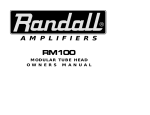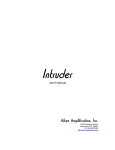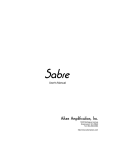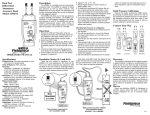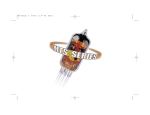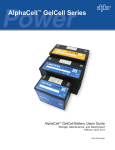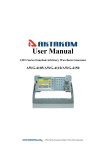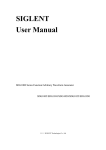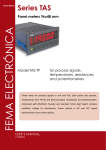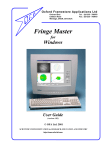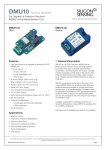Download Randall RT250
Transcript
A M P L I F I E R S RT2/50 MIDI SWITCHING TUBE POWER AMPLIFIER. O W N E R S M A N U A L Dear Randall Owner, Congratulations on the purchase of your new Randall Amplifier, and thank you for the support of our product line. Randall amps are made to strict quality and consistent performance standards, that will provide you with years of musical satisfaction. Please read the following manual, before operating your new MIDI channel switching tube power amplifier. The innovation of the MIDI switching RT2/50, will take tube versatility to new heights, and your journey begins today. if you ever have any questions or comments, please contact us anytime. Enjoy your new purchase! Warnings: -Do not block any ventilation openings on the sides or rear of the preamp. Always give four inches of proper ventilation to the rear of the preamp. -Do not expose the amplifier to rain, moisture, dripping or splashing water. Do not place objects filled with liquids on or nearby the amplifier. -Do not expose the amplifier to direct sunlight or extremely high temperatures. Always unplug the AC power cord before changing fuses or tubes. When replacing fuses, use only the same type and rating. -Be sure to connect to an AC power supply that meets the power supply that meets the power supply specification, listed on the rear fuse holder. -If there is any danger of lightning occurring nearby, remove the power plug from the wall socket in advance. -Do not use excessive force in handling control buttons, switches and controls. Do not use solvents to clean the unit, wipe off the exterior with soft cloth. ! EXCLAMATION POINT: The exclamation point within an equalateral triangle, is intended to alert the user of the presence of IMPORTANT OPERATING AND MAINTENANCE OR SERVICE INSTRUCTIONS in the literature accompanying the product. WARNING GRAPHIC ON PRODUCT: WARNING RISK OF ELECTRIC SHOCK DO NOT OPEN ! GROUNDING: To prevent electric shock, DO NOT DEFEAT THE 3 PRONG GROUNDING PLUG on product’s power cord. Do not use an adapter, extension cord or outlet unless the blades can be fully inserted to prevent blade exposure. WARNING GRAPHIC ON PRODUCT: FIRE OR ELECTRICAL SHOCK, CAUTION: TODOPREVENT NOT EXPOSE TO RAIN OR MOISTURE ATTENTION RISQUE DE CHOC ELECTRIQUE NE PAS OUVRIR IMPORTANT SAFEGUARDS THESE WARNINGS APPLY TO ALL RANDALL ELECTRONIC PRODUCTS. PLEASE READ AND OBSERVE ALL WARNINGS AND INSTRUCTIONS CONTAINED IN THIS SERVICE MANUAL AND THOSE ON YOUR RANDALL PRODUCT PRIOR TO ITS USE. WARNINGS AND SYMBOLS: LIGHTNING FLASH: The lightning flash with an arrowhead within an equalateral triangle, is intended to alert the user of the presence of uninsulated DANGEROUS VOLTAGE within the product’s enclosure that may be of significant magnitude to constitute risk of electric shock to persons. PRECAUTIONARY WARNING: RAIN AND MOISTURE: To reduce the risk of fire or electric shock, DO NOT EXPOSE THIS UNIT TO RAIN OR MOISTURE . Operators of electronic products should in no way be in contact with water. Front panel Features and controls: Channel switching: The RT2/50 has a three selection from panel switching control. The front button selects between Channel 1(Selection 1), Channel 2(Selection 2), and bypass mode (Selection 3). Each channel can be MIDI programmed to the desired module or preamp channel. To select and save the channel you want to use, simply set to the desired channel, push and hold the channel button for 2 seconds and release. The bypass mode can also be programmed to quickly eliminate any noise when finishing a tune. Program the bypass mode the same as you would Channel 1 or 2. Volume controls: The front panel features two separate volume controls, one for each channel. These knobs control the level of output for each channel. Density controls: Each channel as features a density control knob. This knob boosts the amount of overall low end in your guitar tone. This is an additional low end EQ control that should be set to your desired liking. Presence controls: A Presence control can also be found on each channel. This knob boosts the amount of overall hi-end and sparkle in your tone. This is an additional hi-end EQ control, that should be set to your desired liking. Tube Bias Section: Very cool specialized feature. This section allows you quickly and easily change or replace your power tubes, and correctly bias the tubes. Please refer to the Bias section, later in this manual. Please refer to pages 5 & 6 for details functions and uses. Play/Standby: This switch is mainly used to protect and save the life of your power tubes. Once the power has been turned on, this switch puts your amplifier in standby or play mode. Please switch to standby position when not using the amp for a short period of time, like set breaks, to save the life of your power tubes. Select the play position when ready to use the amplifier. Always switch to Standby position before turning off the power switch. It is recommended to turn on the main power switch, and allow the amplifier to warm up at least 30 seconds before turning this switch to play mode. Power Switch: This is the main AC power switch. The switch turns the unit on or off for the amplifier. IMPORTANT: Make sure the amp is in Standby mode, anytime your turning the power on and off. Rear panel features: 1. AC Power/Voltage Selector: This amplifier can operate at AC currents of 100V, 110V, 120V, 230V. Simply remove the fuse with a small screwdriver, and line up the correct voltage with the arrow, and plug back in. After selecting the correct voltage, connect the AC power cord the wall socket. 2. MIDI IN/THRU: These jacks allow the RT2-50 to be used with a any MIDI capable guitar preamp. The IN is the main input for the MIDI connection, and The THRU passes the signal on to other MIDI capable units. When used with the RM4 or other MIDI guitar preamps, connect the THRU of the RM4 or other preamp, to the IN of the RT2-50. See pages 9 & 10, for programming functions and uses. 3. Impedance select (Channel 1/2): Set this switch to the correct ohm rating of your internal and external speaker cabinet. Make sure when using a combination of speaker cabinets, that you select proper impedance, depending on the correct ohm ratings of the cabinet. 4. Main Inputs (Channel 1/2): These are the main signal inputs. Connect a high quality 1/4 patch cable, for the output of the RM4 or other guitar preamp, to the Channel 1 input. When using the channel switching mode, you must use channel 1 input first. In Switching mode, Channel 1 inputs controls Channel 1 and 2 outputs. When using Stereo mode, you can use Channel 1 and Channel 2 inputs. 5. Switching/Stereo switch: The RT2-50 has 2 modes of operation, 100 watts of Stereo operation, and 50 watts per channel in mono Switching mode. When assigning a specific channel to your guitar preamp, you must use Switching mode. Stereo mode can be used for running multiple cabinets at the same time. Tip: Switching mode can also be used with multiple cabinets, so you can switch back and forth between cabinets. Simply connect to Channel 1 input of your RT2-50 from your guitar preamp, and in switching mode, run a speaker cable from both Channel 1 and Channel 2 outputs to different cabinets. This allows you to run different sounds out of different cabinets and switch between them. 5. Main Outputs (Channel 1/2): These are the main output, which is currently connected to your internal speakers. This can also be used as the main output for an extension cabinet. YOU MUST USE THE MAIN OUTPUT FIRST. 5. Extension Outputs (Channel 1/2): Used to connect to an external speaker cabinet. It is very important that you select the correct impedance when adding an extension cabinet. EXTENSION OUTPUTS WILL NOT WORK UNLESS THE MAIN OUTPUT IS BEING USED! MTS Power Tube Bias System What is bias? Simply put, it is a circuit inside the power amplifier section that controls the idle current that flows through the power tubes. Much like the idle speed on a car. There is an optimum setting where the engine (amplifier) is running (idling) fast (hot) enough to keep it from stalling (distorting) but not too fast (hot) to cause excessive wear and overheating. Get it? Why don t all amplifiers have bias or idle current adjustments? Most do but typically involve removing the amp chassis from the box, exposing you to very dangerous high voltage. Special test equipment and knowledge of amp circuits and tubes is also needed. Not a skill most musicians possess and shouldn t need to. Why would I want to adjust the bias? All power tubes are different. They all have unique sonic and electrical characteristics. The MTS amplifiers are designed to accept a variety of different tube types. EL34, 6L6, 5881, 6CA7 and 6550 are among the possible choices. Because they are all different, they each require different bias settings for safety, reliability and optimum performance. Please read the following instructions on how to use this cool feature……. The MTS Series of products from Randall takes the danger and mystery out of bias and puts it safely into the users hands. You will need a decent quality digital voltmeter capable of measuring in the 100 millivolts DC range. This is a very basic type of meter available at any electronic supply house or Radio Shack. They typically cost anywhere from $10 to $25. About the cost of one bias adjustment from your local amp tech. You will also need a small, flat blade screwdriver to turn the adjustment control. 1) The amp should be on, standby in the PLAY position and all knobs all the way down. 2) Turn the meter on and set for reading DC millivolts. Consult the meter instructions for how to do this properly. Since all meters are different it is extremely important that you thoroughly understand what you are looking at on the meter display. 3) Insert the Black (Negative) meter lead into the panel hole labeled COMMON . 4) Insert the Red (Positive) meter lead into the panel hole marked TEST POINT 1 . 5) You typically will observe a reading between 25mVDC (25 millivolts DC) and 45mVDC (45 millivolts DC). Some meters may read .025 volts to .045 volts. Be sure you understand what your meter is telling you. 6) With your screwdriver, turn the BIAS ADJUST control to obtain the proper reading for your tube type from the chart below. Write this number down. 7) Next, move the red meter lead to the hole labeled TEST POINT 2. Write down the value. Both readings from steps 6 and 7 should be within the range shown on the chart. Readjust if needed to get both tubes into the proper range of readings. 8) Lastly, keep the red test lead in the TEST POINT 2 hole and move the Black meter lead to TEST POINT 1. You should read less than 5mVDC (5 millivolts DC) or .005VDC. If the reading is greater, this indicates the tubes are not very well matched. It doesn t necessarily mean they are defective, just not matched. If the reading is greater than 8mVDC (8 millivolts DC) or .008VDC, we recommend replacing the pair with a closer matched set. 9) After completing the adjustments, allow at least 5 minutes for the tubes to warm up and stabilize. Then recheck and readjust if needed. Lower settings will typically sound a bit cleaner and harder while higher settings tend to be a bit more compressed and softer. Find a range you prefer. You should always check the bias readings whenever you replace output tubes and re-adjust if needed. Since we ve made it so simple, there is no reason to not do it. BIAS READINGS: 6l6/5881 EL34/6CA7 E34Ls 6550 28mV 30mV 35mV 35mV to to to to 35mV 38mV 45mV 45mV Meter displays differ from one meter to the next. Some may indicate for example, 30.0 for 30 millivolts. Others may show .030 for 30 millivolts. Knowing how you meter works if of the utmost importance. Additional features of the “POWER TUBE BIAS SECTION” Fast Blo fuses. One per output tube. In the event of a power tube failure, the corresponding fuse will open protecting the amp from additional damage. A red LED next to the fuse will indicate that the fuse is blown. If this happened in the past, you would need to take the amp to a repair shop. They would then hold it for ransom while you figured out how to raise enough money to pay them to fix it. No more. The amp will now tell you if you have a shorted output tube and which one it is! With the power off, simply remove the power tubes and replace the indicated fuse with a FAST BLO 250mA (1/4 amp). NEVER EVER use anything but a FAST BLO 250mA (1/4 amp) fuse. If you do have the misfortune of blowing an output tube, we strongly suggest replacing the pair. Remember, your amp will only perform as well as your weakest tube. Special Note: You should always carry a spare pair of power tubes, fuses, screwdriver and your voltmeter with you. If a tube fails at a gig, you could be back up and running in a matter of minutes. Try that with any other amp. Advanced theory (for those who care): Those of you with electronic knowledge may notice we are referring to current draw but are making measurements in millivolts. Ohms law states that I=E/R or current (I) equals voltage (E) divided by resistance (R). Inside the amp are one ohm resistors in the cathodes of the output tubes. The external test points allow access to those resistors. When you measure across those resistors at the rear panel test points, you are reading the DC voltage drop across a one ohm resistor. Referring to ohms law, if R=1 in the formula, then I = E or current equals voltage. So when you read for example, 30mV you are also seeing the equivalent value of current or 30mA. WARNING: Do not be tempted to run your tubes hotter than the maximum values in the chart. You may find it sounds really cool as you destroy your expensive tubes and possibly damage your amp, of course voiding your warranty! Also, in case you haven t found out the hard way yet, power tubes get extremely hot (as high as 800 degrees)!!!! NEVER touch the tubes while the amp is on. Always allow at least 5 minutes for the tubes to cool before touching them after turning the amp off. MIDI CHANNEL SELECTING The channel switching function of the RT2-50 can be used with any MIDI capable guitar preamp. The RT2-50 was designed to compliment the RM4 modular preamp, but will also give you tube power for all the current MIDI digital guitar preamps. PROGRAM CHANNEL SWITCHING 1. First connect a 5-pin MIDI cable from the THRU jack on RM4 or other MIDI guitar preamp, to the IN jack on the rear panel of the RT2-50. 2. First select the module or channel from your preamp that you will be assigning to the certain power tubes. 3. Once you have the selected the preamp channel, select which RT2-50 channel you want to program to this particular preamp channel. 4. After you have selected the preamp channel and RT2-50 channel you want to use, simply press and hold the RT2-50 channel select button for 3 seconds, and it is now programmed for that preamp channel. 5. Repeat this process to program any of your modules or preamp channels, to be used with the desired power tubes. 6. Once you have programmed all the your modules or preamp channels, to the specific power tubes, you can now use the RF4 or MIDI footswitch to select both the preamp and power tubes at the same time. 7. (SEE THE FOLLOWING PAGE FOR PROGRAMMING THE FOOTSWITCH) PROGRAMMING THE FOOTSWITCH When using the RF4 MIDI foot controller (optional), it must be programmed to each channel, before it will work correctly. After connecting the RF4 foot controller to the MIDI in on the rear panel of the RM4, Please follow the list below to correctly program the RM4 with the MIDI foot controller. 1. First connect the RF4 using the 7-Pin MIDI cable to the IN on your RM4 or MIDI guitar preamp. 2. Push #1 button on the foot controller 3. Set to Channel 1 on the RM4 preamp. (Both the foot controller and the RM4 should be on Channel 1 4. Press & hold the Channel button on the RM4 for 2-3 seconds. 5. Push # 2 button on the foot controller 6. Set to Channel 2 on the RM4 preamp. (Both the foot controller and the RM4 should be on Channel 2. 7. Press & hold the Channel button on the RM4 for 2-3 seconds. 8. Repeat process for channels 3 & 4. Push #3 button, select to Channel 3 on the RM4, push the channel button for 2-3 seconds. Push #4 button, select to Channel 4 on the RM4, push the channel button for 2-3 seconds. If this process does not program the foot controller to the RM4, turn the unit off/on, and repeat the process. Please contact our customer service dept., if you should have any questions or problems. CUSTOMER SERVICE TEL: (800) 877-6863 ext. 230 or e-mail: [email protected]










